May 22, 2025 | 09:12 GMT +7
May 22, 2025 | 09:12 GMT +7
Hotline: 0913.378.918
May 22, 2025 | 09:12 GMT +7
Hotline: 0913.378.918
SRP (Sustainable Rice Platform) is a set of international standards for sustainable rice production recognized by many countries around the world. In An Giang province, rice production in the recent time following the SRP is based on methods of "3 decrease, 3 increase" and "1 must, 5 decrease". It has also been supported by the VnSAT project through the provision of more equipment and better infrastructure.
Moreover, the project also helps train farmers and cooperative groups/cooperatives to apply new scientific and technical measures, thereby reducing costs, protecting laborers’ and consumers’ health meeting inquiries of rice business enterprises, and approaching sustainable production.

The VnSAT project has greatly supported An Giang farmers in rice production following the SRP standards. Photo: Le Hoang Vu.
For many years, An Giang farmers have improved awareness on "clean" production knowing that it can help reduce costs and stabilize yields. With VnSAT project support, their products are always consumed by businesses and can meet the demands of domestic and foreign markets.
Typically, An Binh Agricultural Cooperative (An Binh commune, Thoai Son district, An Giang province) is one of the pioneer cooperatives in the SRP rice production.
Mr. Trinh Cong Minh, Chairman of Directors’ Board of An Binh Agricultural Cooperative, said that along with the support of businesses, the cooperative also received great assistance from the VnSAT project in producing rice meeting international standards. Accordingly, the cooperative has been assisted to invest in building headquarter, representative offices, showrooms, warehouses, and machines for rice seed production, etc.
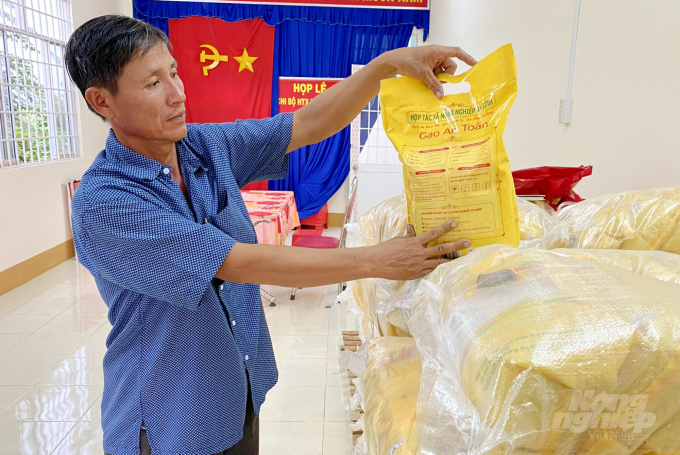
An Binh Agricultural Cooperative has built its brand name "An Binh 1 Safe Rice" which has been certified by An Giang province People's Committee as an OCOP product. Photo: Van Vu.
Mr. Minh was pleased to say that, on the basis of rice cultivation under SRP standards, farmers can sell rice at a high price and receive an additional VND1,000/kg. Thus, this has encouraged the cooperative to build its brand name "An Binh 1 Safe Rice", which has been certified by the Provincial People's Committee as one of the province’s OCOP (one commune, one product).
Mr. Doan Ngoc Pha, Deputy Director of the VnSAT project in An Giang province, said that during the project implementation, the An Giang Management Board has coordinated with the provincial Sub-Department of Rural Development to select An Binh Agricultural Cooperative as a model in improving and expanding large field areas, synchronous mechanizing and improving post-harvest processing capacity. The project has also coordinated with the Vision Investment and Communication Joint Stock Company to support building the brand name "An Binh 1 Safe Rice".
To cope with a high increase in the prices of fertilizers and pesticides, that has caused difficulties for rice farmers in the Mekong Delta, the Ministry of Agriculture and Rural Development (MARD) and localities in the region are currently strengthening the implementation of a program on restructuring the rice export industry. Priority has been given to accelerating the application of scientific and technical advances to production focusing on "3 decrease, 3 increase" and "1 must, 5 decrease" models with the application of the economical watering technique of “wet-dry alternately” in rice cultivation.
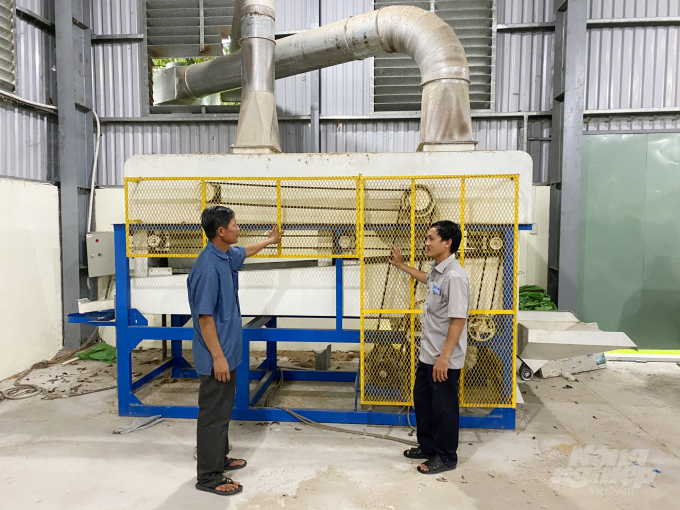
The VnSAT project supports many equipment and machines to improve infrastructure and enhance the capacity for agricultural cooperatives in An Giang. Photo: Le Hoang Vu.
At the same time, new techniques have been applied to focus on reducing the volume of rice seeds. Previously, according to the old practice, farmers sowed from 150-200 kg of seed/ha, now it has reduced to 100-120 kg/ha. As a result, it has significantly reduced investment costs in seeds, fertilizers, and pesticides by about VND2-3 million/ha/crop depending on the production area.
An increase in the use of certified rice varieties to above 75% has helped raise yields and quality of commodity rice, significantly reducing production costs, bringing higher profits to producers, and improving competitiveness for the export rice industry.
Mr. Truong Kien Tho, Deputy Director of An Giang Department of Agriculture and Rural Development, said: “Data published by An Giang Department of Finance shows the production cost for summer-autumn rice crop 2021 in the province was VND4,197/kg and for the autumn-winter crop was VND4,017/kg. The cost is most affected by fertilizer price. Therefore, in the winter-spring crop of 2022, if the price of agricultural materials continues to increase, the rice production cost/kg will also increase.”
In the winter-spring crop 2021-2022, An Giang has 230,000ha of rice. The time of sowing for the winter-spring crop coincided with the time of Covid-19 outbreaks and a high increase of agricultural material price had caused heavy pressure on farmers. Therefore, right from the beginning of this year's crops, the agricultural sector has offered many technical solutions to help farmers reduce investment costs but still get profits.
First of all, it is necessary to reduce expenditures that have a direct impact on production costs such as fertilizers, pesticides, seeds, and harvest facilities by applying technical advances such as the use of more machines, drones in pesticide spraying, and fertilizing …
In particular, the VnSAT project has also promptly promoted activities to improve the quality of program “3 decrease, 3 increase” and “1 must, 5 decrease” to encourage farmers to reduce seeds, fertilizers and pesticides, apply the water-saving method and restart the program on integrated nutrient management in fertilizing so that to effectively save costs for fertilizers in the context of high price increases.
“For the current time of difficulties, the An Giang agricultural industry desires to take the most advantages of scientific and technical measures in rice cultivation so that to reduce most production costs.
The agricultural sector always creates the most favorable conditions for farmers to develop agricultural production under models of cooperative groups and cooperatives so that to gradually reduce individual production. Only then can farmers quickly access new scientific and technical advances thus can reduce investment costs by 20-25%,” said Mr. Truong Kien Tho, Deputy Director of An Giang Department of Agriculture and Rural Development.

Methods of “3 decrease, 3 increase” and “1 must, 5 decrease” are optimal measures to reduce costs in rice farming. Photo: Van Vu.
Translated by Linh Nguyen
![Reducing emissions from rice fields: [2] Farmers’ commitment to the soil](https://t.ex-cdn.com/nongnghiepmoitruong.vn/608w/files/news/2025/05/05/dsc08881jpg-nongnghiep-140632.jpg)
(VAN) Clean rice cultivation model in Thuong Tan commune, Bac Tan Uyen district, is assisting local residents in achieving sustainable agriculture by substantially reducing costs, increasing productivity, and protecting the environment.

(VAN) At the conference to disseminate Resolution No. 68, AgriS introduced its digital agricultural ecosystem and reaffirmed its commitment to accompanying the Government in promoting private sector development and sustainable agriculture.

(VAN) 'Blue Ocean - Blue Foods' initiative is designed to restore marine ecosystems and establish sustainable livelihoods for local communities by cultivating a minimum of 1,000 hectares of cottonii seaweed in the first three years.
/2025/05/21/4642-3-112707_603.jpg)
(VAN) The V-SCOPE project has made direct contributions to three out of six pillars of the Comprehensive Strategic Partnership between Vietnam and Australia.
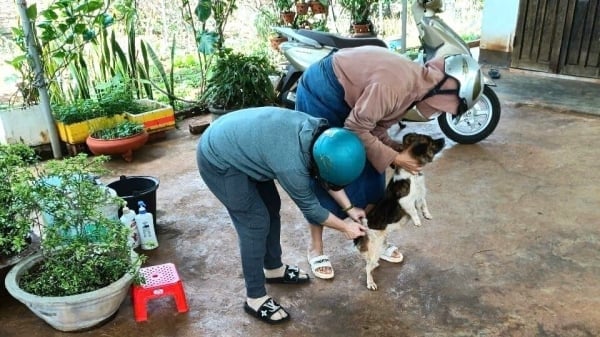
(VAN) Facing the threat of rabies spreading to the community, Gia Lai province urgently carries out measures to vaccinate dogs and cats on a large scale.
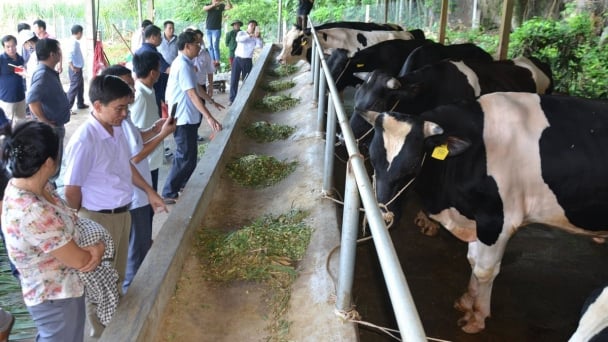
(VAN) Disease-free livestock farming not only protects livestock herds but also stabilizes production and livelihoods for many farmers in Tuyen Quang.
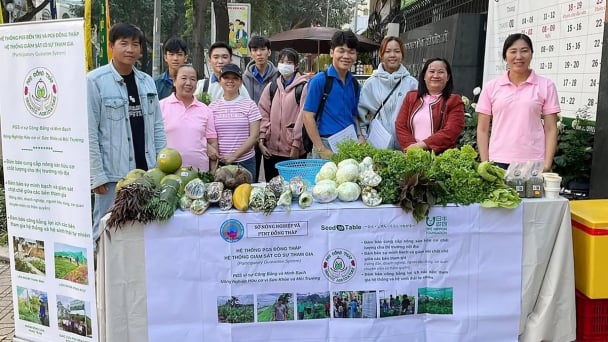
(VAN) Japan's grant aid project contributes to capacity building, promoting organic agricultural production, and fostering sustainable community development in Dong Thap province.